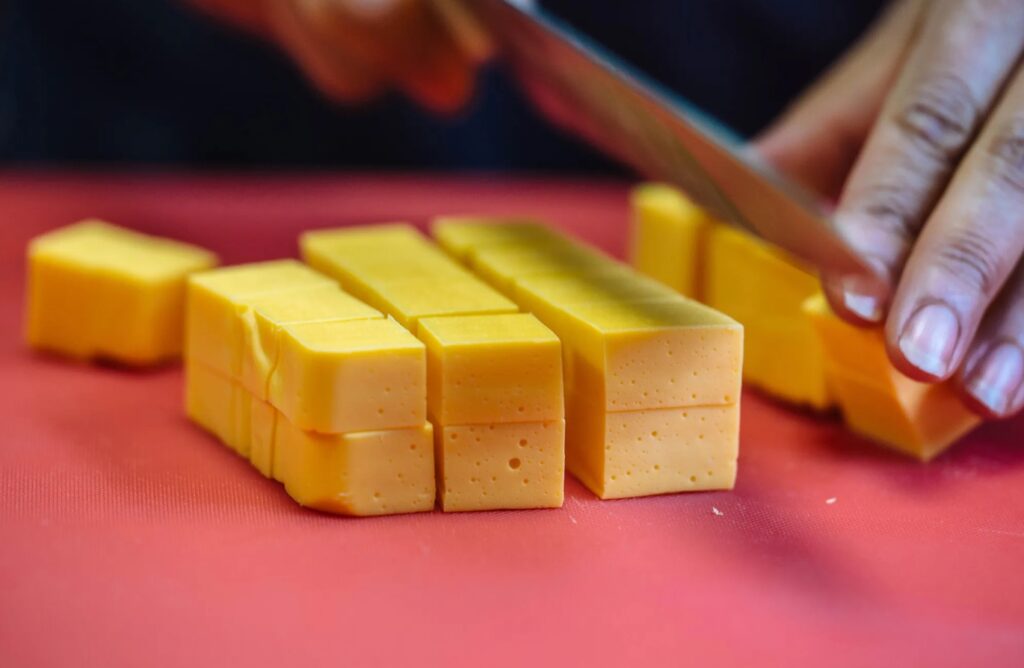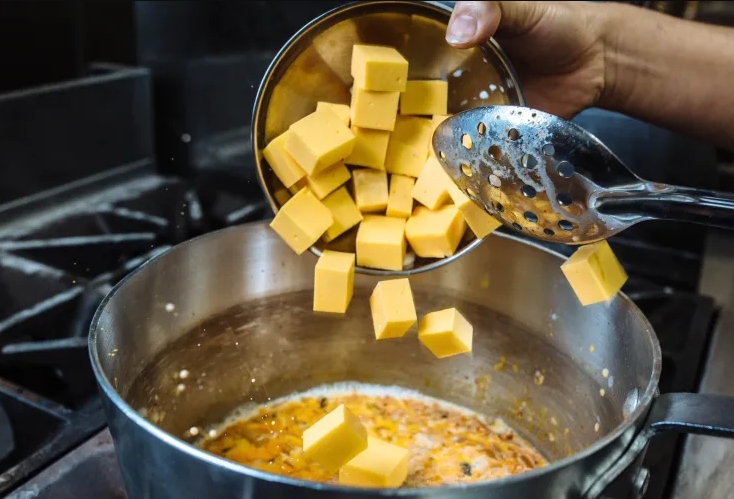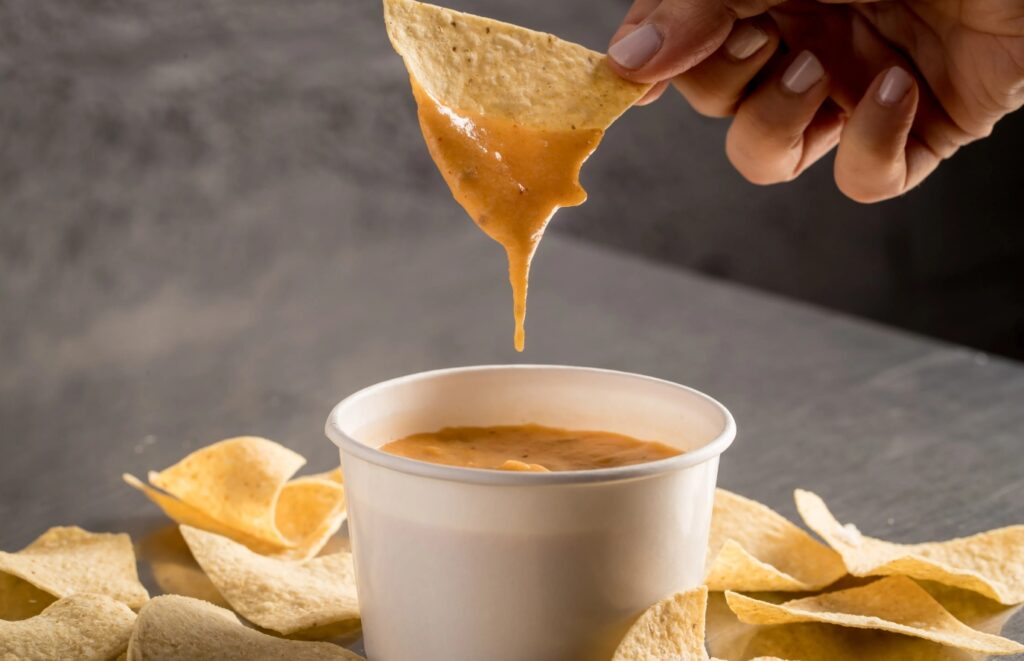If you’ve ever sat down at a Tex-Mex restaurant in Texas, chances are the first thing that hit your table was a warm bowl of queso surrounded by tortilla chips. It’s the dish that gets everyone dipping before the main meal even arrives. But queso is more than just melted cheese.
It’s a cultural marker, a dish with a history that stretches from ancient traditions in Mexico to modern-day parties in Texas homes.
What Exactly Is Queso?
Queso literally means “cheese” in Spanish, but in Texas, it refers to something much more specific. When someone asks for queso, they’re talking about chile con queso, a cheesy dip often blended with tomatoes, chiles, and spices. Served hot and creamy, it’s the glue that holds together countless gatherings, from football watch parties to backyard barbecues.

The beauty of queso lies in its versatility. You might encounter the familiar Velveeta-and-Ro-Tel combo at a family potluck, or a skillet of queso fundido with chorizo at a sit-down Mexican restaurant. Every variation has its fans, but the shared joy comes from gathering around and dipping in.
From Aztec Roots to Spanish Influence
The origins of queso go back centuries. The Aztecs had their own versions of cheese, crafted from milk brought in through early farming practices. When the Spanish arrived in the 1500s, they introduced European cheese-making methods along with cows and goats, blending traditions that eventually shaped the Mexican cheese culture.

In northern Mexico, dishes like queso fundido began to appear—melted cheese often mixed with roasted peppers or sausage, eaten with tortillas. This set the foundation for what Texans would later adapt into their own style of queso.
Queso Arrives in Texas
Fast forward to the early 1900s. San Antonio became one of the first places where queso made its way into restaurant menus. Otis Farnsworth, who opened the Original Mexican Restaurant in 1900, served a version of chile con queso that became popular with both locals and travelers.
Over the decades, Mexican immigrant families and Texas cooks put their own spin on the dish. American cheese entered the mix, melting smoother than traditional cheeses, and soon processed cheese products like Velveeta became staples. This shift made queso easier to prepare at home, and it spread like wildfire through Texas kitchens.
By the mid-20th century, queso was cemented as a must-have at parties, largely thanks to the pairing of Velveeta and Ro-Tel canned tomatoes. Ads from the 1940s and 1950s promoted the combination, and home cooks embraced it. The dip was cheap, easy, and consistently delicious.
Why Texans Fell in Love With Queso
Queso isn’t just food—it’s social. Think about it: everyone gathered around one bowl, dipping chips, laughing when someone loses a chip in the gooey cheese. That shared experience is a big part of its charm.

Its popularity also comes down to comfort. Queso’s creamy texture and mild spice make it a dish that appeals across generations. Kids love it, adults crave it, and it pairs with almost anything. It’s no surprise queso earned the title of “the national party dip of Texas.”
The Cheese That Made It Possible
Queso’s texture depends on the cheese. Traditional Mexican cheeses like Oaxaca, Asadero, or Chihuahua melt beautifully but aren’t always available outside certain regions. In Texas, processed cheese like Velveeta became the standard because it melts smoothly without breaking apart.

Still, many restaurants and home cooks experiment with blends. Monterey Jack, cheddar, and even cream cheese find their way into recipes. Pepper Jack brings heat, while queso fresco might be sprinkled on top for contrast. The choice of cheese shapes the queso’s flavor, from sharp and tangy to mellow and buttery.
Regional Styles and Variations
Not all queso is the same, and regional differences tell their own stories.
Classic Tex-Mex Queso: Velveeta plus Ro-Tel, usually spiced with jalapeños.
Queso Blanco: Made with white cheeses like Monterey Jack, smoother and lighter.
Queso Fundido: Served bubbling in a skillet, often with chorizo, eaten with tortillas instead of chips.
West Texas Green Chile Queso: Incorporates Hatch green chiles, giving it a smoky kick.
Bob Armstrong Dip: An Austin favorite at Matt’s El Rancho, layered with taco meat, guacamole, and sour cream.
Today, chefs even experiment with fusion versions—kimchi queso in Dallas, or Indian-inspired queso made with chutneys. It proves queso is flexible enough to embrace different cultural flavors while keeping its Texas heart.
Queso in Pop Culture
You don’t have to be from Texas to recognize queso’s impact. National Queso Day on September 20th is celebrated across the U.S. Movies and TV shows feature it, from Jack Black’s “Nacho Libre” to moments in “Breaking Bad” and “The Office.”
But queso’s biggest pop culture moment might have been Chipotle’s infamous 2017 queso debut. The chain wanted to offer a “real ingredients” version, but Texans quickly declared it a flop. For locals, queso isn’t about being fancy—it’s about comfort, tradition, and a consistency you can rely on.
What to Dip and Pair With Queso
Chips are the classic, but queso plays well with so much more:

Soft pretzels and bread cubes.
Fresh veggies like carrots, celery, and bell peppers.
Fries or potato wedges for a Tex-Mex twist on cheese fries.
Mini tacos, quesadillas, or empanadas for a heartier snack.
Grilled meats, especially skewers of chicken or beef.
It’s also the perfect topper for nachos, burritos, or even burgers. Texans know there’s no wrong way to enjoy queso.
The Legacy of Queso in Texas
At its core, queso tells the story of Texas itself: a blend of Mexican heritage, American innovation, and immigrant creativity. It reflects a culture that values gathering together and celebrating through food.
From Lady Bird Johnson’s recipe published in the 1960s to local cookbooks and Junior League creations, queso has been passed down and reinvented over generations. And while debates continue over which style is “authentic,” the truth is that queso’s authenticity lies in its role as a unifier.
Closing Bite
The next time you dip into queso, you’re not just tasting cheese and chiles. You’re dipping into a dish with deep roots and a legacy shaped by families, restaurants, and home cooks across Texas. Queso has moved from Aztec beginnings to Spanish influence, from San Antonio restaurants to football tailgates, and from Velveeta commercials to fusion menus.
So grab a chip, scoop up that cheesy goodness, and know that you’re part of a story that continues to evolve with every bowl served. And if you’re ready to taste even more of the history and flavors that make Dallas special, come join us on an Incloodie Food Tour. Book your spot today and experience Texas food culture in the most delicious way possible.
